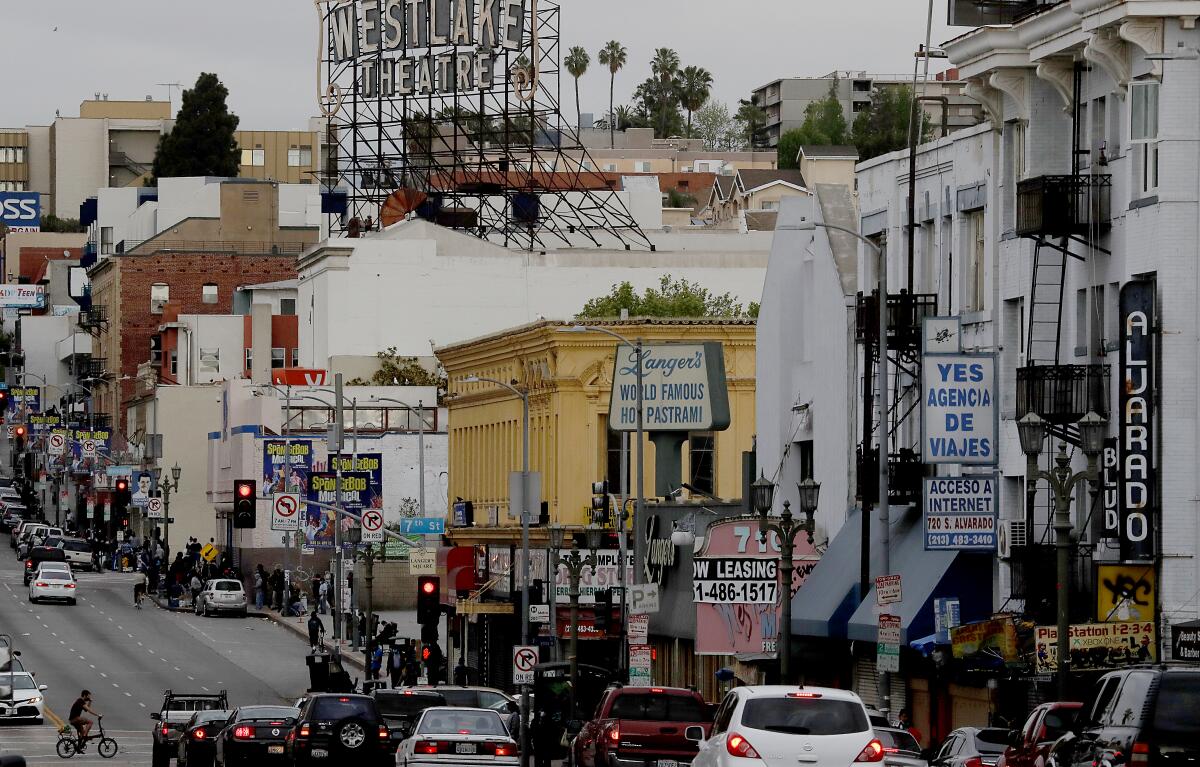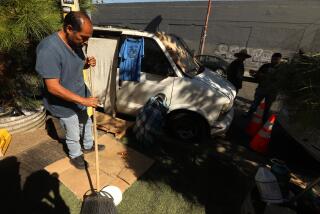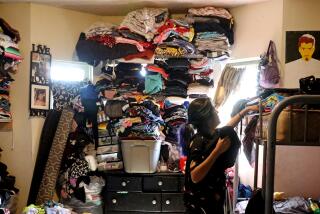L.A.’s most crowded neighborhoods fear outbreaks: ‘If one of us gets it, we are all going to get it’

- Share via
Lorenzo Salinas doesn’t know how he’ll pay next month’s rent, much less how he would keep his whole family from getting sick if one of them fell ill with the coronavirus.
There’s little space to spare in the two-bedroom apartment in South Los Angeles where he lives with his wife and three children, ages 11 to 20.
“I think we’d have to stay outside,” said Salinas, who lost his job at a restaurant over a month ago. “Now we’re all shut in. The apartment feels smaller and more uncomfortable than usual.”
These are some of the unusual new scenes across the Southland during the coronavirus outbreak.
Salinas and his family live in one of the most crowded ZIP Codes in the United States, according to a Times population-adjusted ranking. Nearly 24% of the homes there are considered “crowded” — having more than one person per room, excluding bathrooms, the analysis of Census Bureau data shows.
The neighborhood’s coronavirus infection rate also ranks it among the top 40 communities out of more than 300 across Los Angeles County, figures from the county health department show.
As COVID-19 cases climb across L.A. County, its overcrowded housing could play a role in accelerating the spread of the disease, according to public health officials and researchers.
Overall, 3.3% of the nearly 121 million housing units in the U.S. are considered crowded. L.A. County is home to five of the 10 most crowded ZIP Codes — including the No. 1 most crowded — in the U.S., the analysis shows.
Some of the most cramped living conditions in the country are found in lower-income neighborhoods such as Historic South Central, Westlake and Pico-Union.
Renters in unincorporated L.A. County now have new tools to prevent eviction following a vote by the Board of Supervisors in response to the coronavirus.
Although there is some correlation between crowded areas and those with higher rates of confirmed cases in the county, no clear trend has emerged. For example, wealthy enclaves such as Bel-Air and Palos Verdes Estates have some of the highest infection rates even though a small fraction of homes there are crowded.
In New York City, an analysis by the NYU Furman Center finds the disease is more prevalent in areas where more people reside in crowded units. The ZIP Codes with the most infections per capita also had the highest share of overcrowded renters, researchers found.
In London, a study by the New Policy Institute also found that overcrowded neighborhoods had higher rates of COVID-19 infections than less-crowded areas, with heightened risk in homes that people over 70 share with younger relatives. Researchers said the finding raised “policy questions about the practicability of advice on social distancing for people whose housing conditions make self-isolation impossible.”
These are some of the unusual new scenes across the Southland during the coronavirus outbreak.
Health officials in L.A. County say they’re concerned that people living in overcrowded housing may be at greater risk for contracting the virus.
A team at the county Department of Public Health is trying to gather more detailed information about patients who have been hospitalized with COVID-19, using data on housing density where they live to determine whether more crowded neighborhoods are being hit harder, director Barbara Ferrer said last week.
“We’re as concerned as you are about trying to better understand the conditions that make spread easier,” Ferrer said. “Obviously, everything we know about this virus means that the closer you are in contact to other people the easier it is to spread.”
There has been such limited and uneven access to testing, health experts say, that rates of death and hospitalization are a better indicator of the virus’ actual toll. But it remains impossible to determine whether people in overcrowded communities of L.A. are being hospitalized or dying at higher rates because officials have not released numbers breaking those indicators down beyond the county level.
Dr. Coco Auerswald, associate professor at the UC Berkeley School of Public Health, says she believes that neighborhoods with greater crowding will see higher rates of deaths and hospitalizations from coronavirus infection, “not because I have any kind of inside information, but because it’s not rocket science from a public health standpoint. It’s obvious.”
Crowded, low-income communities are in a “far more risky situation than those living in a Norman Rockwell one — the single-family household with a backyard like I have, where people have the privilege of sheltering in place,” she said.
“These communities have large numbers of people in big family units where lots of people are coming and going, many of them in essential jobs,” Auerswald said. “Every person in that household that’s going out, that’s another vector of possible infection coming into that densely populated space, by virtue of being out there with a highly infectious pathogen, and doing the jobs that are more likely to be exposed.”
Health officials acknowledge that some of the key measures they are urging to limit the virus’ spread among members of the same household are impractical for people living in cramped apartment units.
Under county guidelines, people who are confirmed or presumed to be infected with the virus must self-isolate for seven days after their symptoms appear and another 72 hours after they subside. Anyone who has been in close contact with them, and potentially exposed, must self-quarantine for 14 days.
That means staying at home at all times, keeping at least six feet away from other people in your home, and using a separate room and bathroom if possible. No preparing food, caring for children or handling pets.
Ferrer acknowledges that those steps are “really difficult” to practice when living in close quarters. In homes without spare rooms, Ferrer suggested using “a cloth drape or some other physical barrier to create a space that allows you to be separate from other people in your home,” cleaning the bathroom after each use, and disinfecting objects and surfaces you must touch.
In Echo Park, Jennifer Lopez and her boyfriend live in a one-bedroom apartment that is so cramped they typically take turns napping and taking care of their three children. More than 15% of homes in their ZIP Code are crowded, ranking it in the top 100 nationwide. The infection rate, however, falls below the county’s overall rate.
She worries her job at a shelter for homeless youths puts her at a higher risk of coronavirus infection. If she gets sick, she admits there will be almost no way to contain the spread in their household.
“If one of us gets it, we are all going to get it,” said Lopez, 37. “We just don’t have any free space.”
Larry Gross, executive director of the Coalition for Economic Survival, said overcrowding in L.A. County is the result of a housing crisis fueled by years of rising rents and stagnating wages. Renters are caught in an “economic vice that keeps squeezing them” as they face difficult choices about how to pay for housing, gas, food, medicine and clothes for their children, he said.
“For many, the only option to ensure that roof over their head is to move in with more people, whether it’s family members or friends,” Gross said. “Then they’re able to share the rent, and that’s the only way they can make rent.”
The affordable-housing shortage is putting people at a greater risk because many of those renters are struggling to practice social distancing in tight living spaces, he said.
“Once again, we have people with the lowest incomes having to deal with the greatest risk in this pandemic because of their economic situation,” Gross said.
The Times analysis is based on 2014-2018 estimates of the American Community Survey, which asks respondents to report the number of rooms in their dwellings, as defined by the U.S. Census Bureau. That measure includes bedrooms, kitchens and living rooms and excludes bathrooms, hallways, outdoor areas and unfinished spaces. The analysis ranked each ZIP Code tabulation area by statistically weighing its number of households and how much its crowding rate deviated from the national average.
Public health experts have long known that overcrowding is bad for the spread of infectious illness.
“Crowding just facilitates close contacts of infected people,” said Dr. Lee Riley, a professor of epidemiology and infectious diseases at UC Berkeley. It’s a consequence of poverty, he said, and “only one of many important factors that drive up respiratory infections like COVID-19,” including a lack of health insurance, a high prevalence of underlying medical conditions or working in the informal economy where lockdowns aren’t feasible.
In cities like Los Angeles, crowding has been fueled by the scarcity of affordable units, which has more families doubled up, sharing homes with relatives and living in multi-generational households.
Many low-income people can’t afford to rent their own places, so instead they move between different friends’ and relatives’ homes, creating an “intertwined and ever-shifting web of households,” said Danya Keene, an assistant professor at the Yale School of Public Health.
“This web of households is not conducive to social distancing,” Keene said, and that instability “is only likely to increase as COVID-related economic and job losses exacerbate existing barriers to affordable housing.”
As they pass the time in their South L.A. apartment, Salinas said his family was faring OK, for now. They only leave home to buy groceries, wearing face masks and gloves.
But some potential hazards are out of their control, like the people who don’t wear masks and ride the same bus to the market. And he worries about how they’ll keep germs out of the home once their money runs out and he has to find another job.
“I’m the only one who works,” he said. “So it’s going to be difficult.”
More to Read
Sign up for Essential California
The most important California stories and recommendations in your inbox every morning.
You may occasionally receive promotional content from the Los Angeles Times.
















